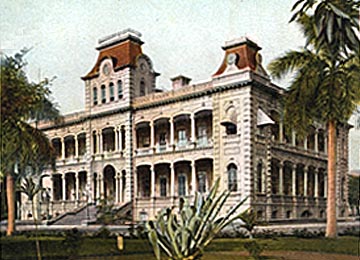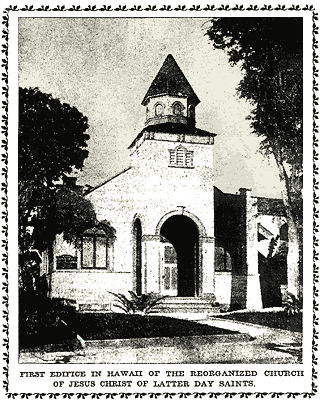
READINGS IN EARLY MORMON HISTORY
(Newspapers of Hawaii)
Misc. Hawaii Newspapers
1900-1999 Articles

"Executive Building" (Iolani Palace), Honolulu: c. 1900
1844-1899 | 1900-1999
Bull Oct 01 '07 | Adv Oct 02 '07 | Adv Oct 05 '07
Bull Oct 12 '07 | Adv Oct 13 '07 | Adv Oct 14 '07
Bull Oct 14 '07 | Gaz Oct 22 '07 | Adv Nov 03 '07
Bull Nov 04 '07 | Gaz Nov 05 '07 | Adv Nov 06 '07
Frnd Aug '19 | Frnd Feb '25 | StarB Feb 02 '25
ParaPac Jul '26 | Adv Apr 26 '40 | Adv Apr 27 '40
Return to Old Newspaper Articles Index
Vol. IX. Honolulu, Tuesday, Oct. 1, 1907. No. 3810.
SMITH IS
COMING TO DEDICATE. KANSAS CITY, Mo., Oct, 1. -- Joseph Smith of the Latter Day Saints left here today for Honolulu, where he will dedicate a church. |
 Vol. XLVI. - No. 7847. Honolulu, Wed., October 2, 1907. Price 5 ¢
PRESIDENT JOSEPH SMITH KANSAS CITY, October 1. -- Joseph Smith has left here en route to Honolulu to dedicate a church there. |
 Vol. XLVI. - No. 7850. Honolulu, Sat., Oct. 5, 1907. Price 5 ¢
ELDER SHEEHY COMES WITH PRESIDENT SMITH. President Joseph Smith, of the Reorganized Church of Latter Day Saints, will be accompanied on his visit here, to dedicate the new church on King street, by Elder F. M. Sheehy, one of the twelve governing elders of the denomination. |
Vol. IX. Honolulu, Saturday, Oct. 12, 1907. No. 3820.
ELDER JOSEPH SMITH Elder Joseph Smith, presiding officer of the Reorganized Church of Jesus Christ, arrived from the Coast this morning in the Alameda. |
 Vol. V. Honolulu, Sunday, Oct. 13, 1907. No. 250.
THE CHAMPION POLYGAMY FIGHTER "This man is the world's champion against polygamy," said Elder F. M. Sheehy, of the Reorganized Church of Jesus Christ of Latter Day Saints, introducing a representative of the Advertiser to President Joseph Smith, the ecclestical leader of the church and the eldest son of Joseph Smith, the Prophet. "President Smith has written, preached and lectured more against that crime than any man living." |
 Vol. XLVI. - No. 7857. Honolulu, Mon., Oct. 14, 1907. Price 5 ¢
CHURCH DEDICATED BY With simple but effective ceremonies and services, the first church edifice of the body of Christians known as the Reorganized Church of Jesus Christ of Latter Day Saints was dedicated yesterday morning. |
Vol. IX. Honolulu, Monday, Oct. 14, 1907. No. 3821.
ELDER SMITH The dedication ceremonies of the Reorganized Church of Jesus Christ were held yesterday forenoon at 11 o'clock in the neat little church of that denomination on King street. |
 Vol. L. Honolulu, Tuesday, Oct. 22, 1907. No. 85.
ONE WIFE AT ONE TIME ENOUGH. President Joseph Smith of the Reorganized Church of Jesus Christ of Latter Day Saints gave an address last evening at the new King street church on "The Utah Apostacy." The church was well filled, there being quite a number of the members of the Utah branch of the church present, besides quite a number from other churches. |
 Vol. V. Honolulu, Sunday, Nov. 3, 1907. No. 253
SEER AND PROPHET A most admirably appointed luau was given yesterday afternoon at the residence of Mr. and Mrs. Henry Paoa, in honor of President Joseph Smith and Elder Sheehy of the Reorganized Church of Jesus Christ of Latter Day Saints. It was the first occasion of the kind either of these gentlemen had experienced, and was thoroughly enjoyed by them and by a number of other visitors in the Islands and by a company of at least three hundred kamaainas of longer or shorter residence here. |
Vol. IX. Honolulu, Monday, Nov. 4, 1907. No. 3839.
VISITING ELDERS Elders Smith and Sheehy, of the Reorganized Church, will have one experience to relate when they return to Missouri. It will be of a grand luau tendered in their honor by Mr. and Mrs. Henry Paoa at their residence at Waikiki. |
 Vol. L. Honolulu, Tuesday, Nov. 5, 1907. No. 89.
SEER AND PROPHET A most admirably appointed luau was given yesterday afternoon at the residence of Mr. and Mrs. Henry Paoa, in honor of President Joseph Smith and Elder Sheehy of the Reorganized Church of Jesus Christ of Latter Day Saints. It was the first occasion of the kind either of these gentlemen had experienced, and was thoroughly enjoyed by them and by a number of other visitors in the Islands and by a company of at least three hundred kamaainas of longer or shorter residence here. |
 Vol. XLVI. - No. 7877. Honolulu, Wed., Nov. 6, 1907. Price 5 ¢
PROPHET FOR OPEN DOOR Speaking out not only as a teacher and a preacher, but as a prophet, and as one propheseying of Hawaii, President Joseph Smith of the Reorganized Church of Jesus Christ of Latter Day Saints, the anti-poltgamites, he who is the son of the Prophet Joseph Smith, last night told a representative of the Advertiser that Hawaii has a serious problem to face in the consideration of the assimulation of races. He referred to the exclusion of Chinese from the United States as an injustice not only against the race, but against the country as a whole and against these Hawaiian Islands in particular, inasmuch as here in this wonderful little arena of the Pacific is the working-out ground of the amalgamative forces which will have much to do with influencing the tendency of the nation in the handling of the cosmopilites who enter America through the Hawaiian portal. |
 Vol. ? Honolulu, Hawaii, Aug. 1919. No. ? A Golden Wedding Anniversary. Tuesday, August 5th, was a gala lay out on Punahou street. From four to six in the afternoon autos were parked in the street and the Rapid Transit brought callers by the score to the home of Dr. and Mrs. J. M. Whitney. It was surely a brilliant affair for even the trade-winfs had done their part by carpeting the lawn with scarlet petals from the Poinciana Regia, while within, the parlors were flooded with the golden sunshine of blooming flowers. There was the golden shower for a background and peeping from under a table was a bunch of great calendra, like golden eagles lighting up the dark; California poppies pouring from their cups the sunset colors of the "Golden West," and wee Hawaiian wild flowers carrying golden wishes and fragrant memories, the friendships of other days. |
 Vol. ? Honolulu, Hawaii, Feb. 1925. No. ? The Passing of Mrs. Whitney. Mary S. Rice Whitney was born in Cleveland, Ohio, November 29, 1837. February 2, 1925, she laid aside the body, the house in which she had been living, and was clothed upon with her new body, the "house not made with hands, eternal in the heavens." |
Vol. XXXII Honolulu, Monday, Feb. 2, 1925. No. 10325
FIRST AND ONLY W.C.T.U. Mrs. John M. Whitney, one of the well-known kamaaina residents of Honolulu, passed away at her home this morning at 9:30 o'clock. Mrs. Whitney came to Honolulu from Ohio after her marriage in 1869 and had lived in Honolulu almost continuously since then. |
Vol. 39 Honolulu, Hawaii, July, 1926. No. 7
Dr. Whitney is Ninety: One day, not long ago, a stranger and a long-time resident of Honolulu were walking in Punahou, one of the older home sections of Hawaii's capital -- whence, alas, some of the historic landmarks, both house and tree, are disapperaring, as is the fortune of growing cities, to make way for modern buildings. |
 No. 19,176 Honolulu, Hawaii, Apr. 26, 1940. No. ? Mormon Elder Gives Lecture. At the Reorganized Church of Jesus Christ of Latter Day Saints, 1680 Mott-Smith Drive, Elder Harold I. Velt, missionary in charge of Hawaii, last night continued his lectures on the civilization of the pre-Columbian Americans, and discussed the causes of their decline. |
 No. 19,177 Honolulu, Hawaii, Apr. 27, 1940. No. ? Reorganized LDS Sect Not Mormon. The Advertiser yesterday inadvertently referred, incorrectly, to members of the Reorganized Church of Jesus Christ of Latter Day Saints as "Mormons." The difference is this: The Church of Jesus Christ of Latter Day Saints, founded April 6, 1830, was reorganized after the death of the leader, Joseph Smith. The reorganized church established headquarters at Independence, Mo., and called itself the Reorganized Church of Jesus Christ of Latter Day Saints. Those who, in the reorganization, chose to continue under the leadership of Brigham Young, eventually established headquarters at Salt Lake City, Utah, and they are called "Mormons." Members of the Reorganized Church, for which Elder Harold I. Velt is now conducting a series of lectures here, are not called Mormons. |
Back to top of this page.
Articles Home Page | Newspaper Articles Index | History Vault
Oliver's Bookshelf | Spalding Studies Library | Mormon Classics
last updated: Jan. 1, 2006
